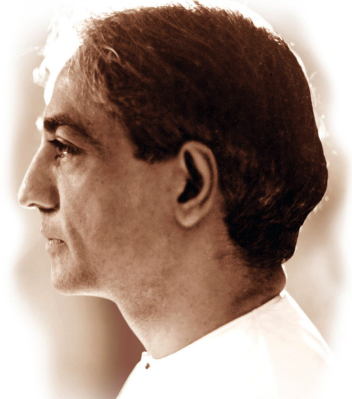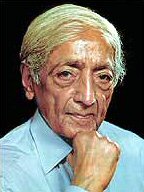Krishnamurti′s
The First And The Last Freedom.

In this book the discussions range wide - on suffering, on fear, on gossip, on sex, among other topics - but it continually returns to the core concept of freedom: the breaking of the debilitating, consuming concern with the self.
Osho: "I love this man, and I hate this man. I love him because he speaks the truth, but I hate him for his intellectuality. He is only reason, rationality. I wonder, he may be a reincarnation of that goddamned Greek Aristotle. His logic is what I hate. His love is what I respect. But this book is beautiful. This was his first book after his enlightenment... and the last too. Although many other books have appeared they are only poor repetitions of the same. He has not been able to create anything better than The First and the Last Freedom. It is a strange phenomenon: Kahlil Gibran wrote his masterpiece The Prophet when he was only eighteen years old, and struggled his whole life to create something better, but could not. Ouspensky could not go beyond Tertium Organum even though he met Gurdjieff, lived and worked with him for many years. And such is the case with J. Krishnamurti. His book The First and the Last Freedom is really the first and the last." Osho - Books I Have Loved)Commentaries On Living.
The book draws on conversations Krishnamurti held over a decade or more with many hundreds of people around the world. He describes the ways in which the mind is fundamentally conditioned by patterns of thought and experience.
 Osho:
"I want to bring J. Krishnamurti back to your notice again. The name of
the book is Commentaries on Living. There are many volumes of it. It is
made of the same stuff stars are made from.
Osho:
"I want to bring J. Krishnamurti back to your notice again. The name of
the book is Commentaries on Living. There are many volumes of it. It is
made of the same stuff stars are made from.Commentaries on Living is his diary. Once in a while he writes something in his diary... a beautiful sunset, an ancient tree, or just the evening... birds coming back home... anything... a river rushing to the ocean... whatever he feels, he sometimes notes it down.
That′s how this book was born. It is not written systematically, it is a diary. Yet to just read it is enough to transport you to another world... the world of beauty, or far better, beautitude. Can you see my tears?
I have not read for some time, but just the mention of this book is enough to bring tears to my eyes. I love the book. It is one of the greatest books ever written. I have said before that Krishnamurti′s First and Last Freedom is his best book, which he has not been able to transcend - of course not as a book, because Commentaries is only a diary, not a book in the real sense, but all the same I include it." (Osho - Books I Have Loved)
Krishnamurti′s Notebook
download it.At the Feet of the Master
A book attributed to Jiddu Krishnamurti. It is one of the three small classics of
 Theosophy; the two others
are Light on the Path by Mabel Collins, and The Voice of Silence by H.P. Blavatsky.
Theosophy; the two others
are Light on the Path by Mabel Collins, and The Voice of Silence by H.P. Blavatsky.
Osho says about it
in his Books I Have Loved: "There
is a book called At the Feet of the Master. The name of the author as given is
Jiddhu Krishnamurti, but Krishnamurti says he does not even remember having
written it. It was written long, long ago, back when Krishnamurti was only
somewhere between nine and ten years old. How can he remember all that time ago
when it was published? But it is a great work.
I want to disclose for the first time to the world who the real author is: Annie
Besant! Annie Besant wrote the book, not Krishnamurti. Then why did she not call
it her own work? There was a reason behind it. She wanted Krishnamurti to be
known to the world as a master. It was just a mother’s ambition. She had brought
up Krishnamurti, and she loved him just as any mother loves her own child. Her
only desire in her old age was that Krishnamurti become a world teacher,
jagatguru. Now, how could Krishnamurti be declared a world teacher if he has
nothing to say to the world? In this book, At the Feet of the Master, she tried
to fulfill that demand."
- At The Feet Of The Master is online here.
- Read what Osho has to say about Mabel Collin′s Light on the Path